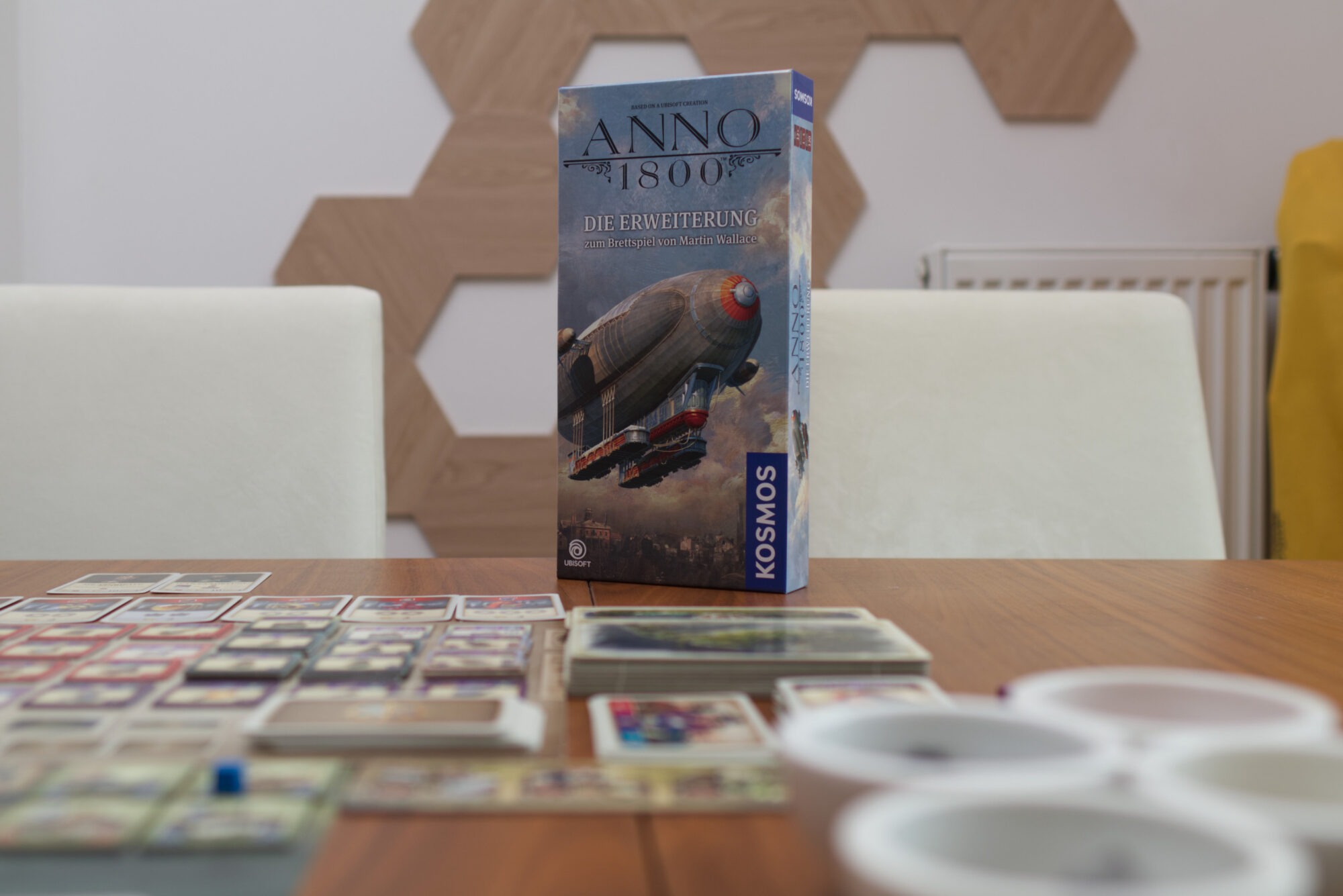Expansions are always tricky to write about. Some of you might never have played the base game and be curious to learn if the combined game is now something they should check out. Others already have played the base game extensively and come with a whole range of expectations what an expansion should and should not do. It’s difficult for an expansion’s designer to deliver on all those expectations, much like it’s difficult for a reviewer to do so. But let me give it a shot and mix up the usual structure a bit!
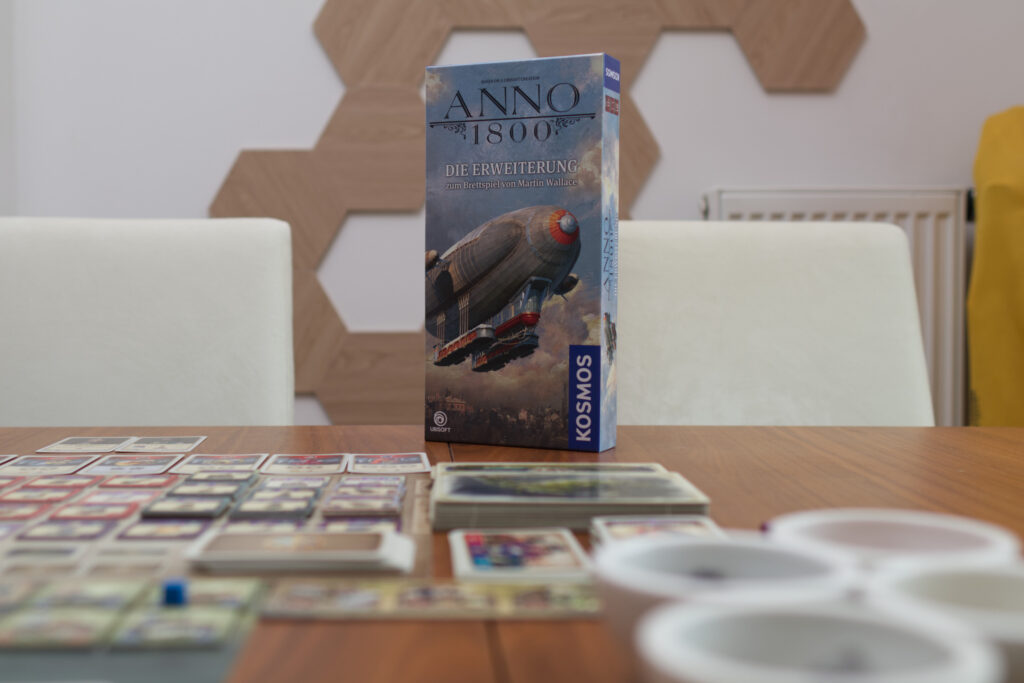
What Has Happened So Far …
If you haven’t already heard of Anno 1800 the board game or simply never had a chance to play it, let me give you the short, short summary: based on an (at least in Germany) widely popular video game license, designed by industry veteran Martin Wallace (yes, that Martin Wallace), Anno 1800 was a bit of a surprise hit when it came out back in 2020. It featured a novel way of dealing with tech trees and resource production without having to actually hand out any resource tokens. Resources are produced on demand by assigning a worker of the required qualification (from simple green to top of the food chain light blue ones) into the respective factory and spending the fruit of their labor instantly. As an alternative, goods can be traded from opposing players (or from their perspective rather involuntary sold) if they have the respective factories and you have the necessary fleet of trade ships.
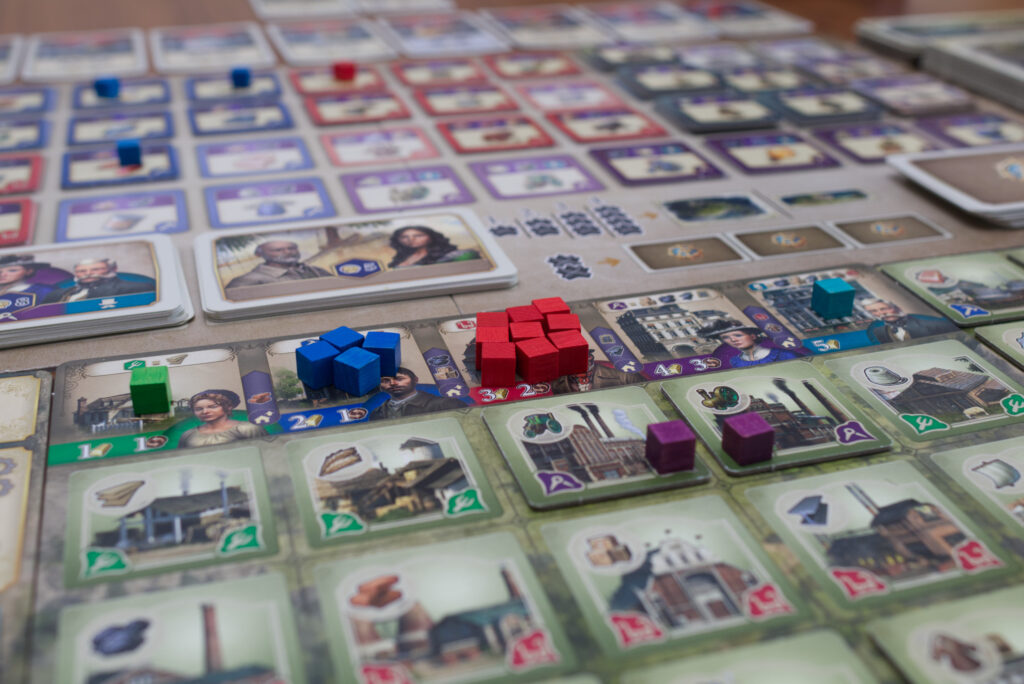
The main goal is to achieve the most VP by satisfying the demands of your citizens. Every new one gained comes with a demand card that requires a particular combination of resources and upon completion will not only provide some nice VP but also comes with a one-time bonus effect. It’s a perpetual engine: get demands, build new factories, have workers produce the required goods to satisfy someone’s demand and receive their bonus, which often is spawning more people with new demands. At some point one runs out of available workers and then it’s time to skip a turn and reset workers instead.
Anno 1800 ran in such breezy turns that the term “micro turn” almost felt inappropriately grand. It was more a case of: You play the factory, I fulfil this demand, you explore the new world, I hire new workers, you … oh, it’s my turn again already? The game ends when someone manages to empty out their whole hand of demands, turning the game into a race: do you rush to end the game early, before your opponents have ramped up their VP production – or – do you go for maximum efficiency and plan to have more VP than the person triggering the end game.
It’s also a “game of chicken” where building a new type of factory is often more beneficial for others than oneself. They can avoid the costs (both in time and resources) of building the factory in favor of simply shopping its product once or twice. As a result, we often ended up in situations where both players circled each other for rounds and rounds, trying to do something, anything valuable instead of them being the one building that certain factory.
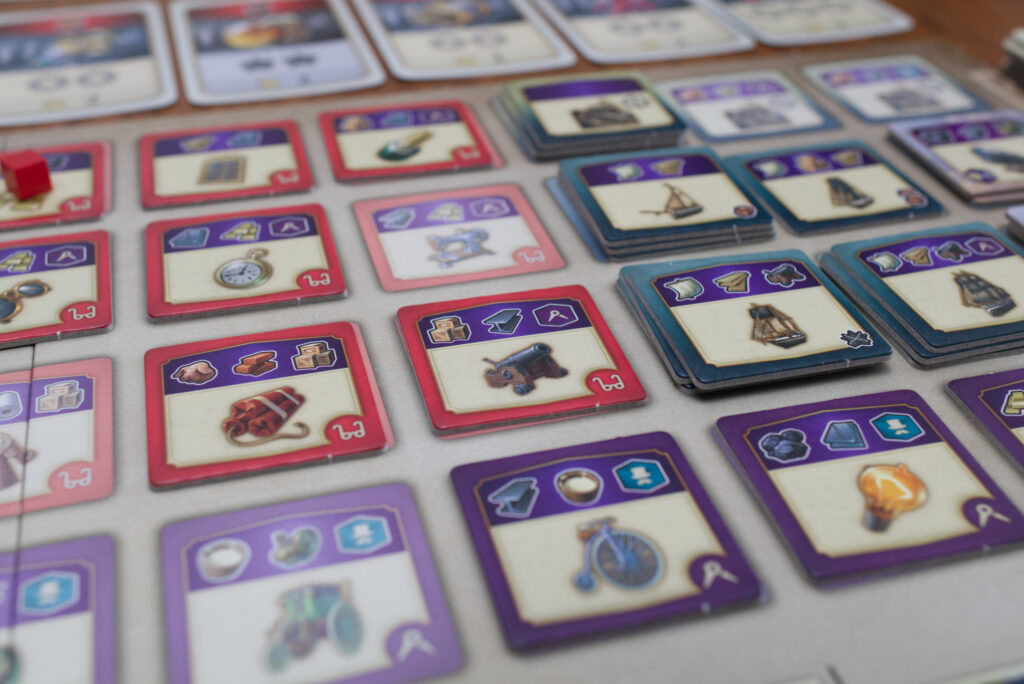
Tweaking the System
While the expansion comes with a whole bunch of new elements, it’s best understood when knowing the base game’s weak points. While Anno 1800 was a lot of fun as is, it had its bumps and rough patches. For example, purple engineers were a key limiting factor to get access to more advanced technologies, but obtaining them either depended on acquiring some expansive goods or luck in drawing a citizen card that provides an engineers as its bonus. The expansion alleviates this somewhat by giving each player one engineer as part of starting setup.
In a similar fashion, the rules for trading have been slightly adapted in that there is now a better kickback. In the base game, the providing player only received a single gold no matter how complex of a good the other player was trading for. Now, selling higher-tier goods provides multiple gold, making it much more worth it to actually open up shop. It feels more like a win-win where it is more difficult to say who won more. Either you get a good that enables you to do something or you get lots of gold that enables you to reactivate spent workers, it’s both attractive.
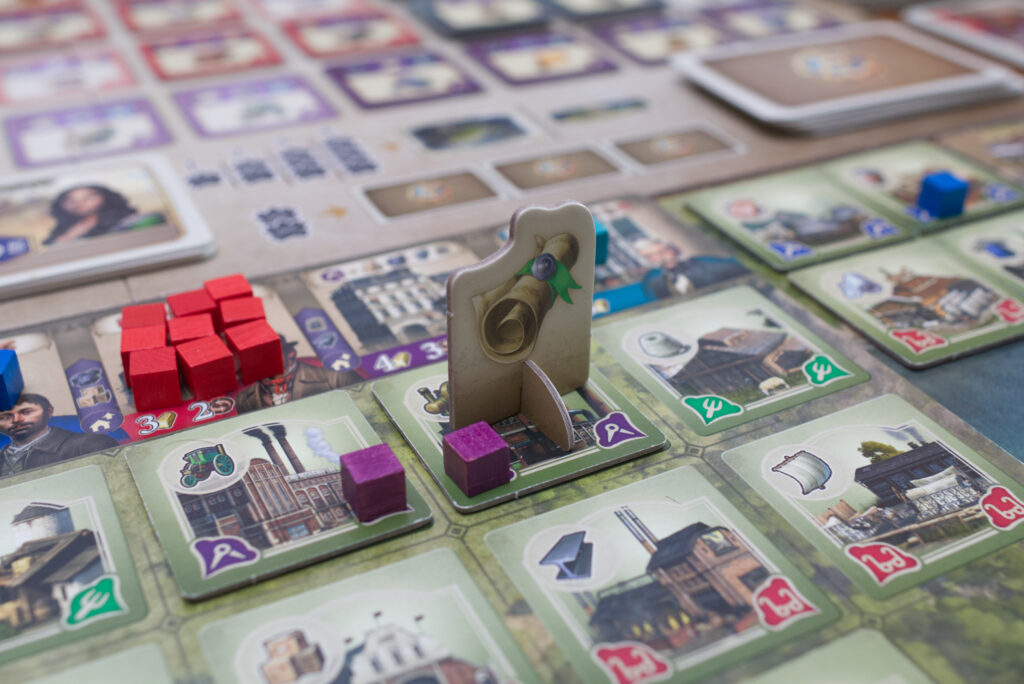
A contributing factor that strengthened that “game of chicken” and sometimes almost brought base Anno 1800 to a halt was the fact that one player might built a key technology (e.g. a factory to produce canons) and then it was the other players that could use it first. This has been addressed with the introduction of “patents”, small cardboard standees that basically prevent others from using that factory before the owner had the chance yourself.
All these changes do a lot to the game’s formula without much need of explaining additional rules. Somewhat surprisingly, the randomness in which new world goods one gets access to due when exploring has not been changed, which would have felt in line with the other modifications.
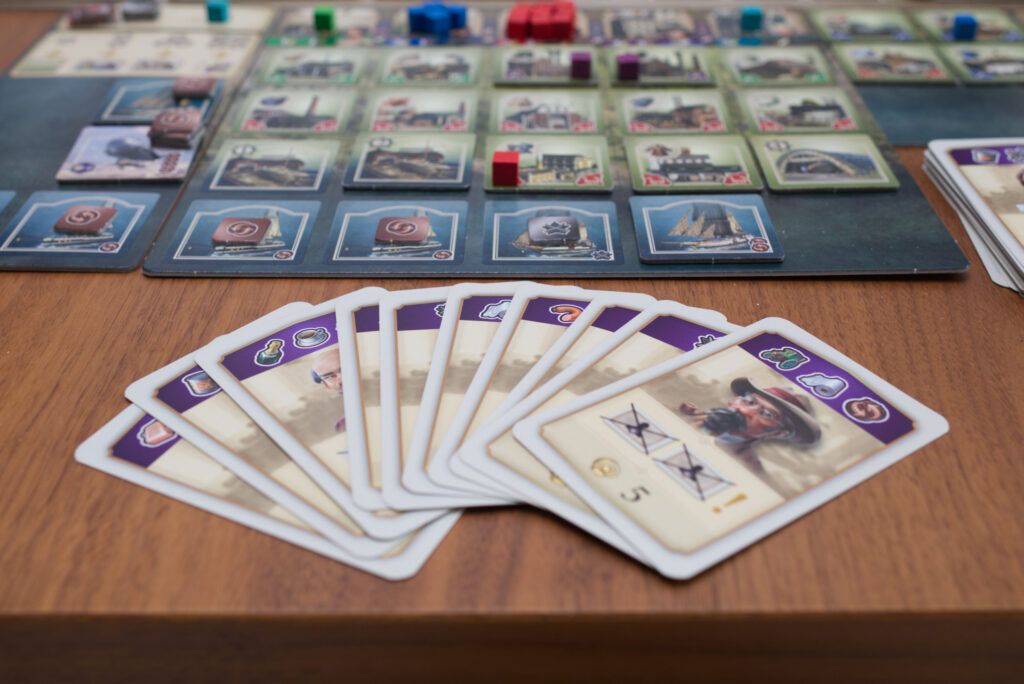
Enabling Existing Elements
Looking at the large array of possible technologies, the base game noticeably wasn’t fully utilising some of them. In the plays I had of base Anno 1800, we hardly ever built the purple techs like steam engines because the game was almost over by then. For a similar reason, we rarely ever used the level three ships and the new world goods only in a limited fashion. We had done so in our very first plays, but players quickly noticed it was just too slow of a strategy. After all, this is a race.
The level 3 ships have now been replaced by more powerful level 4 zeppelins (along with a new “hangar”), otherwise there are no changes or additions to the tech tree. This might come somewhat as a surprise as expansions often extend the tech tree. One can smell the marketing slogan: “now with 40 new technologies!”. Not so here, it’s still the same set as in the base game.
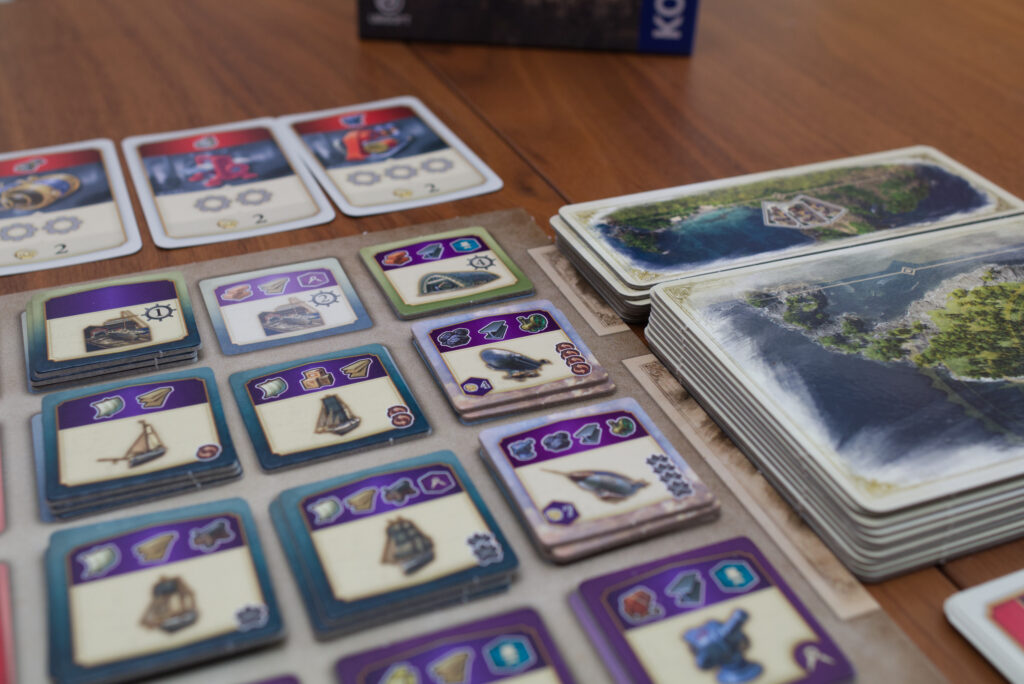
The utility of the existing techs has nonetheless changed dramatically. The power balance has noticeably shifted towards the red workers (which were in constant high demand) and more utilisation of the purple engineers. This has been done primarily by introducing innovation cards that allow converting some higher-tier goods into gear tokens, which in turn can be converted into additional limited actions. For example, spending one gear allows building a new factory without having to spent a full action on it. One still has to pay the resources, but it can be bolted on to another main action. Other conversions allow fulfilling a demand card without spending the main action, and so on.
The way this was implemented will likely create some controversy: there is a shared display of 8 innovation cards that gets refilled after every turn. If one of the techs you can produce is shown there, you can buy that card by producing the product. If not, you are out of luck. Note that goods cannot be traded for in order to claim innovation cards, that have to come from your own factories. This can lead to one person drawing again and again innovation cards for that single tech they built early and others not getting any benefit for theirs at all for multiple rounds. One time, a friend of mine immediately rushed for coffee precisely because there was an innovation card for it in the market and then he continued to draw two or three more coffee cards in a row when refilling the market. In my plays so far, it hasn’t made a game breaking difference, but for high level players, I think it will have a noticeable effect.

Change in Pace
Besides bolstering previously rarely used techs, this changes Anno from an almost nano-turn structure to more like a micro-to-normal turn structure. Players can still only do one main action and now pick up a single innovation card plus do a single gear-to-action conversion, but turns feel more impactful and satisfying.
The game also now starts players off with more space and two more ships, which boosts the early rounds a bit. The overall arc however still remained the same in my experience: explore old world to get access to an additional worker / cheaper tech, try to build the level 2 shipyard as quickly as possible and then extend your fleet of trade ships. Or as an alternative go for new world and claim an innovation, but then go for the level 2 shipyard. I also successfully tried a rush strategy without zeppelins or much of the purple techs and it still worked.
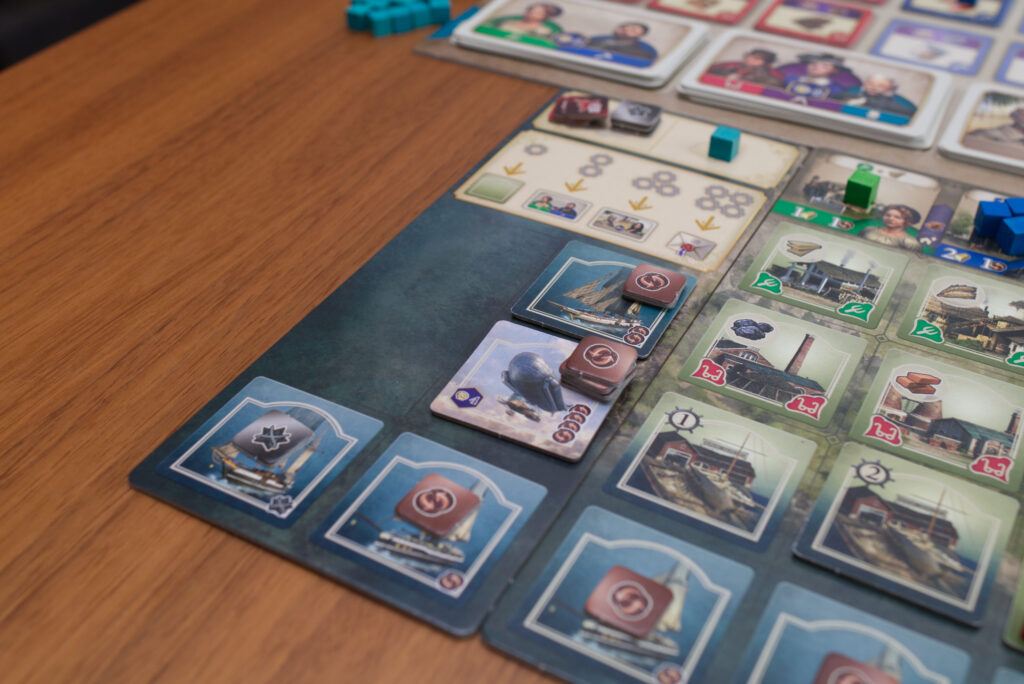
New Goals & Elements
A very welcome addition is the new set of goal cards. One for example adds a penalty (=unrest) to have unused workers when resetting and a 2p-only rules change now reduces techs to a single copy if the techs are mentioned on goal cards. This turned out to be very interesting!
Another goal allows refilling a ship’s trade/exploration tokens by spending a single gear, completely changing the economy. In general, I like the new goals a lot and look forward to have yet one more reason to bring Anno 1800 more to the table again.
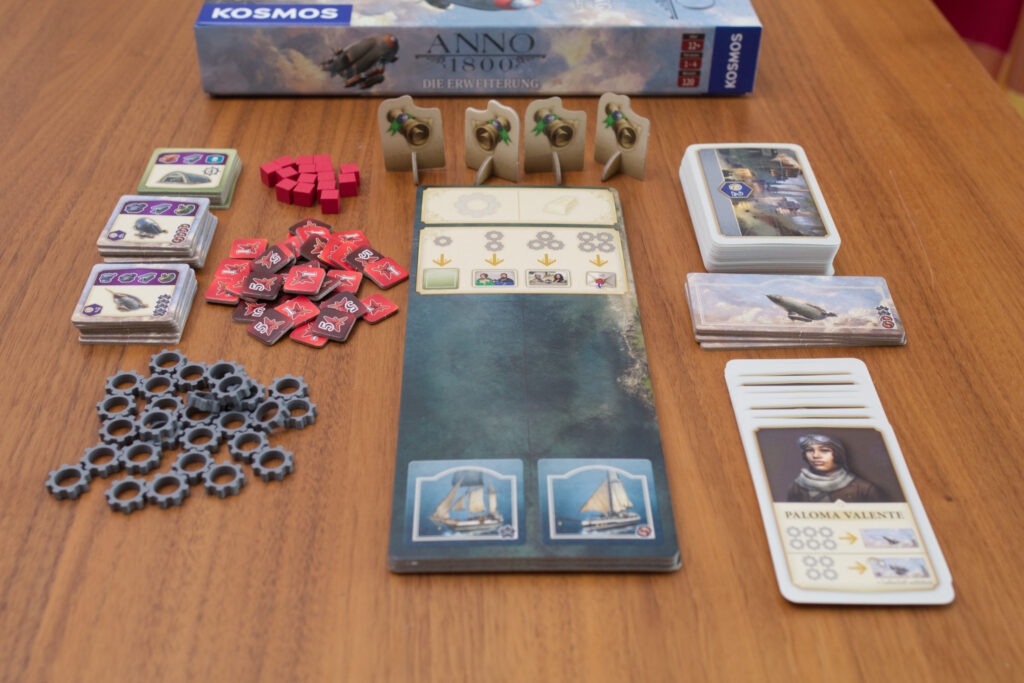
One thing to note is that there are elements in the expansion that only come into play when certain goals are in-play. Namely these are the unrest markers and the hybrid airships.
Solo Campaign & Publishing Woes
Base Anno 1800 never came with an official solo mode … until BGG user Stephen Hurn took up the mantle and basically knocked it out of the park. The 10 chapter story campaign had a rather light fluff story that did enough to induce some character into the rather mechanical base game and it’s step by step introduction of mechanisms not only formed a nice skill progression ladder for the player to climb but also culminated in a general way to play the full game of Anno 1800 solo. I really like Anno’s solo mode and would go so far to say that it made Anno 1800 worth getting just for solo play!
Unfortunately, the solo campaign had a rocky start. First only launched as an Essen Promo, then as a German-only 5€ purchase before it was uploaded as a ready to download (again Germany-only) PDF. I believe I saw an official English translation at some point but it seems to have disappeared with only a fan made translation remaining. The expansion now contains a 6 chapter solo campaign that builds on the same principles but feels a bit condensed, more challenge than tutorial. Again it is a race against a timer constructed out of excess cards with restrictions to how many and which goods one can trade. It works well and is a nice additional incentive to play Anno 1800 more often, I just wished it had more chapters.
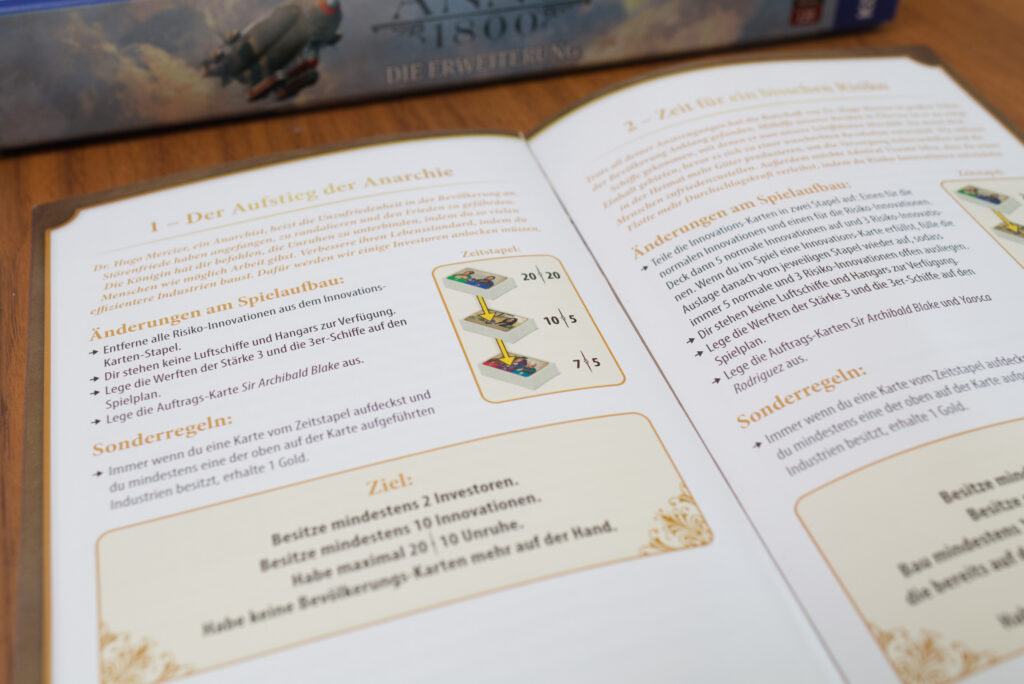
The sad part is that it looks like this won’t be a way for non-German speakers to finally get their hands on an official version of the solo mode because so far there has been no announcement of an English version of the expansion. Except for the rules, all of the components are language neutral with the one exception being some of the goal cards (which are also explained in the rules), so interested players should be able to pick up a German copy via online retailers out of Europe and play with that one.
If memory serves me right, the delay between releases of the German and English base game was almost a year. So who knows, an English version might still see the light of day … my best guess is there might be licensing issues with Ubisoft. Or the market for an expansion isn’t that big and us Germans are just way more crazy about Anno 1800 than the rest of the world 😀
The other thing I – at least a little bit – want to call Kosmos out for is: why not put a designer on the box? The subtitle is carefully phrased as “for the board game by Martin Wallace”. For me, the expansion has Stephen’s handwriting all over it plus of course Martin Wallace himself and the as usually unsung heroes: editors. But whoever designed it, they deserve credit for a job well done.
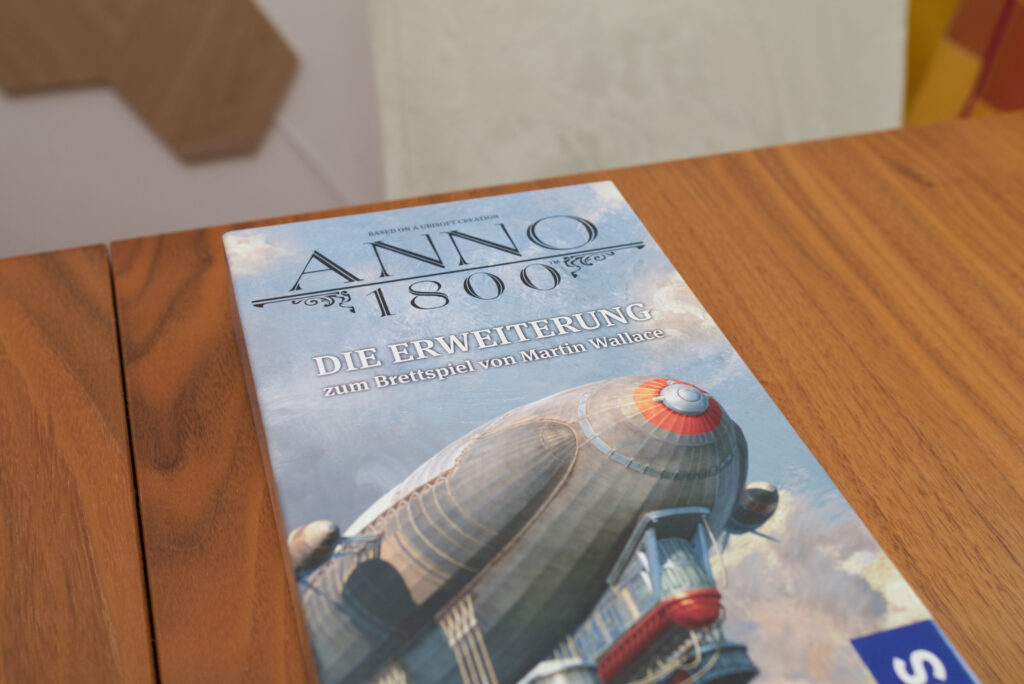
Conclusion
The expansion for Anno 1800 is an unusual one in that it doesn’t add the large new parts of tech tree or opens up a new front on a separate side board that we have gotten used to from other games. There are even zero (!) new citizen cards. Instead, the expansion feels very much like a quality of life / balancing patch. The game arc is basically the same, the playtime is similar to the base game, and a good part of the changes could have been issued as part of an updated rulebook or a downloadable variant.
However, this is one of these cases where the sum of smaller parts creates a bigger whole. It’s the rules tweaks in collaboration with the new zeppelins and the innovation tiles and the … everything just makes a little bit more sense. The only reason why I from now would consider playing without the expansion is if I would teach Anno to new players that don’t play many games because adding the innovation and gears might overburden the already substantial rules teach a bit. For any mid-to-heavy players though, I don’t see an issue just going with the new stuff from the start.

The biggest weak points in this well rounded expansion are for me a) the randomness in the innovation cards and b) their decreasing significance. They start out as something special one craves to achieve even a single time and end up being an automatic thing one does all the time towards the later game. We also quickly established a meta where we almost exclusively used gears to build new factories because the conversion rate into extra actions is so good. The other noticeable effect is that upon first plays, one gets rather inefficient and ends up spending turns for things that could have been done with gear actions, prolonging the game a bit. Or ending up with a whole pile of them when the game ends. Same for gold: we were literally swimming in gold sometimes. But this was mostly on us: There is so much to do and pulling something off feels so good now, it’s easy to lose sight that this is after all an efficiency race. I noticed the same effect with base game Anno where our first play took way longer than our later ones. The solo campaign is a good way to learn how efficient and quickly this game can be won and it might have been nice to add a pacemaker to the multiplayer game as well just to show people where it’s at. But those aren’t serious issues for me compared to how much I enjoyed the rest of the game.
So far, we had a great time with the expansion. It’s a very welcome reason to bring out Anno 1800 again, but it feels more like an evolution than a revolution. Think Underwater Cities: New Discoveries, which similarly became a must for all fans of UC. I wouldn’t be surprised if after a couple of weeks the new and shiny will already start to wane and it will soon be as if there never was a base-game-only Anno 1800, the expansion integrates that smoothly into the game. Still, Anno 1800 was already a mighty fine game on its own and this expansion only makes it better.
To sum it up, my advice is: if you liked Anno 1800, simply get it. Rip open the expansion box, dump everything into your previously half empty base game, and be content. If on the other hand the randomness or the stretches of multiplayer solitaire of Anno 1800 bothered you, this will likely not change that for you. It’s an expansion for people that played Anno, liked it, and were looking for “more”. Not necessary more content, but more impact of each turn and a stronger feeling of having achieved something. To have less artificial stalling for opening up a certain factory and more building something big for yourself. For all parts of the buffalo to make a little bit more sense instead of wondering why certain tiles even existed.
